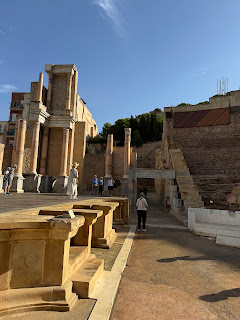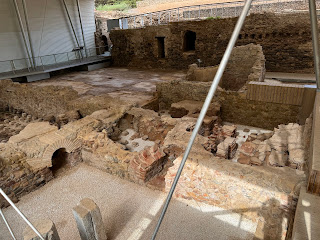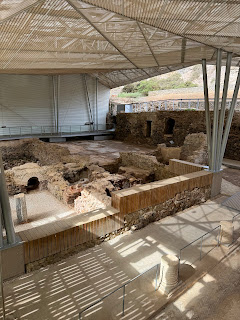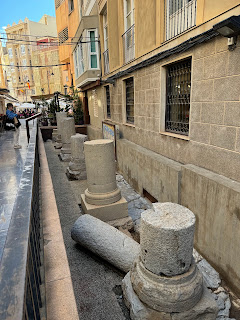It was wonderful sailing into Cartagena ( Carthago Nova or New Carthage) knowing we were seeing what ancient Carthaginians and Romans would have seen as they approached, even perhaps, the harbour, from a distance at least. Even the sleek yachts and sail boats, the technology essentially unchanged.
And as you walked the streets, you quickly sensed and saw the slow decomposition of past civilisations, one built upon the other.
It was founded in 227BC by Hasdrubal the Fair and named Qart Hadasht, Phoenician for New Town. Nothing good lasts for ever. Eighteen years later, in 209 BC it was attacked by the Roman general, Scipio Africanus.
Even today, Scipio is recognised as a supreme strategist, one of the greatest in history and taught as such in military schools. He launched a determined coastal attack which despite their strong defences alarmed the Carthaginians—to the extent they withdrew their troops from their northern wall to withstand the attack. It was what Scipio was waiting for. Mago, the Carthaginian general, calculated, mistakenly, the northern wall was safe enough, protected as it was by a wide lagoon. Scipio, however, had learned that the lagoon was quite shallow and ebbed with the tide. (He conned his soldiers, Neptune had personally informed him of this in a dream.) With the fighting focused on the coastal wall, five hundred Romans waded through the lagoon, clambered the walls and opened the gates.
Renamed Carthago Nova, Cartagena became one of the great cities of the Roman empire, much of its wealth derived from its silver mines. The dream ended in 425 AD when the city was sacked by the Vandals. Some years later the Byzantines took it over, and in 714 AD the city fell under Arab control. Cartagena remained Muslim until 1245 AD when Christian armies swept in and claimed it for Castile.
After years of prosperity the city was in steep decline by the early C20th, still evident in some of the streets. It was the rediscovery of its past that has brought Cartagena renewed prosperity. ‘What have the Romans ever done for us?’ as they say.
The old city is very walkable, a short stroll from the harbour takes you to the gleaming marble paved Calle Mayor, its beautiful baroque buildings a powerful reminder of its golden age of prosperity, at least for the rich.
And who wouldn't like to stay in a hotel like this?
Traditionally the Cathedral of Viega Santa Maria was founded by the apostle St James, who landed here in 1st century AD spreading the word of Christ. When, in the C13th, Christian kings drove out the Moors, a new Cathedral was commissioned on the original site. During the Spanish Civil War 1936-39 the cathedral and surrounding buildings were largely destroyed by arial bombardment, and the future was reclaimed by the past. In clearing the devastation, they discovered the ruins of a vast Roman complex built upon by Vandals, Arabs and later, Christians. As you enter the rediscovered Roman theatre you walk through the bombed cathedral’s foundations.
And as you look out from the theatre you realise how much of Rome lies beneath the modern city.
An archaeologist was asked by a student where would she suggest investigating. Her answer was succinct. ‘Throw a stone and start digging.’ And this is a tribute to Cartagena, in marked contrast to Carthage (see previous post) Their past is everywhere, and everywhere treasured. You can visit recently excavated Roman baths, temple, street and houses and from there see the stuff just outside yet to be excavated. You can walk the streets and see Roman columns in an elegant sprawl. You can browse in a nondescript thrift store and glimpse the past beneath your feet.
In this thrift store you can walk over glass panels showing its Roman substructure. Note my elegant trainers
And ending on a sweet note, we discovered a new way to serve coffee – but only for the non-diabetic and those with sweet teeth. Read how to make it and weep, or alternatively try it.
All in all, one of our favourite cities

































2 comments:
You never know what's beneath your feet, especially in old countries. Over here, we're lucky if we find clovis tools or at best a burial mound. The few ancient peoples we had never built anything more substantial than earthen mounds. A few buildings were preserved from when the Europeans took over a couple of centuries ago, but most of our history was wiped away before being built upon.
In Mexico and South America, there are more permanent stone edifices, but that's mostly the ones they found accidentally. The jungle swallows all.
America has glamour, landscape and a fascinating history of its own. Speaking of landscape, if I had my life again, other than reading more books, I’d study Geology — a deeper kind of history
Post a Comment